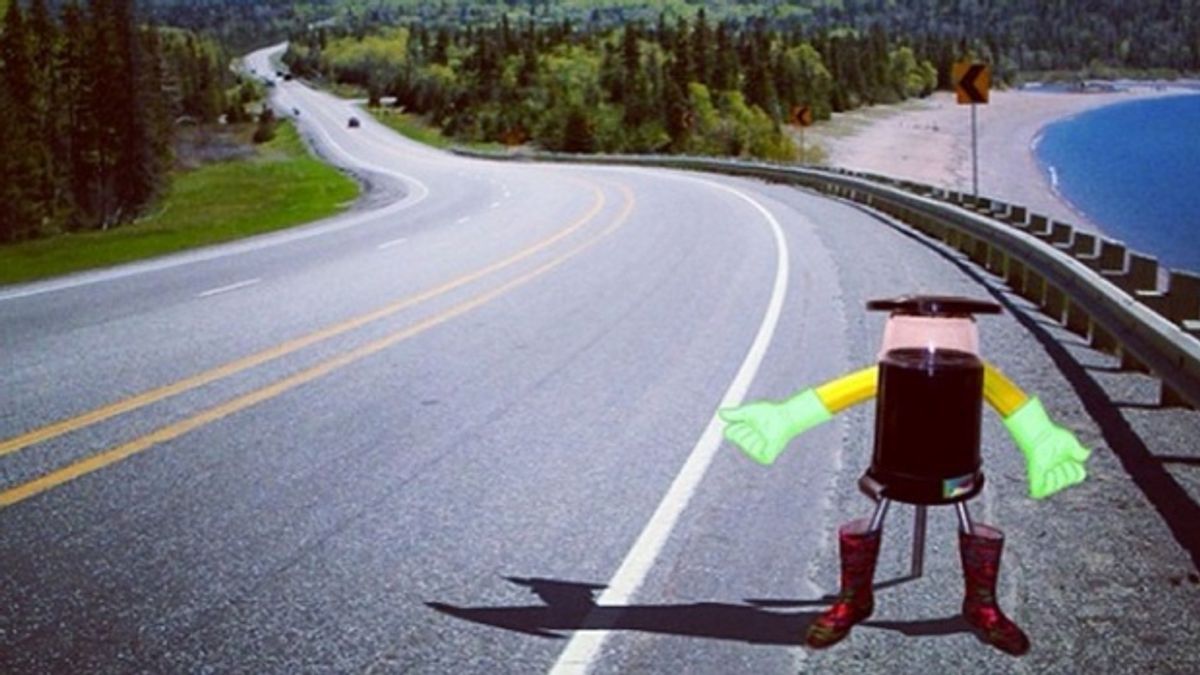We'd better hope that there will never be a time when robots will be able to do absolutely everything without any help from humans, because that's the time when our entire species is likely to become redundant. Until that time comes, the technique of human exploitation is a valuable skill for robots to learn, because it's a great way of being able to complete objectives with a minimum of hardware or software. hitchBOT is a robot that'll attempt to exploit the kindness of humans by using them to transport itself across Canada by simply asking people for a ride.
Traveling across an entire continent would be a remarkable feat for any ground robot. Humans, however, do it all the time. It may be relatively rare for any one single human to make the trip, but as a group, it's happening continuously. Created by researchers from McMaster University and Ryerson University, hitchBOT is going to try to take advantage of this by hitchhiking across Canada, moving from human to human to get where it wants to go. The tricky part is that hitchBOT isn't offering to help out with gas or anything like that: it's going to be relying entirely on people feeling sorry for it and wanting to help out. Once you pick hitchBOT up, it'll make some generalized Wikipedia-based conversation and ask to be plugged into your car's 9v outlet to recharge, all while tweeting about its experiences.
My concern, to be completely honest, is whether hitchBOT has found that appearance sweet spot of cute haplessness that seems to resonate with humans. Its designers describe it as having "some anthropomorphic features, albeit not many. The physical form looks like somebody has cobbled together odds and ends to make the robot, such as pool noodles, bucket, cake saver, garden gloves, Wellies, etc." That's certainly a non-threatening look, but it's quite different from the appearance of other robots that we've seen successfully be able to autonomously manipulate humans through the sheer power of their appearance.
One example of this is Blabdroid, a robot designed to collect the personal stories of people who meet it. Blabdroid has no specific way of convincing anyone to talk to it, but by being small and cute and engaging, it's able to get humans to talk about incredibly personal things.
A second example is Tweenbot, one of the simplest robots ever and also one of our long-time favorites. All that Tweenbot does is drive slowly in one direction, and (much like Hitchbot) it depends on helpful passing humans to make sure that it gets where it needs to go. This video will melt you:
These two robots have a lot in common: they're small. They're simple. They're made of cardboard, which isn't just inexpensive, but is also "soft" and nonthreatening. They have big eyes and a big smile, but otherwise no features that could be anthropomorphized. The rest of their design is explicitly functional. And finally, the way that humans interact with them is very simple and straightforward: Blabdroid has two buttons and asks simple questions in a childlike voice, while Tweenbot is even simpler, with a written sign asking people to help it get somewhere.
hitchBOT, on the other hand, looks a little weird. It has a lot of stuff going on, and a user wouldn't know what (if anything) some of its design features are for, which might be a little scary. It doesn't have any obvious interaction points (like eyes), and it's also bulky and (presumably) somewhat heavy, simply due to its size. Personally, I feel like it looks more like an art project than a robot that I want to stop and help out.
How effective hitchBOT is will be put to the test starting July 27, when it'll leave Halifax, Nova Scotia on it's way to Victoria, British Columbia, a distance of 6,230 kilometers by road.
[ hitchBOT ] via [ The Atlantic ]
Evan Ackerman is a senior editor at IEEE Spectrum. Since 2007, he has written over 6,000 articles on robotics and technology. He has a degree in Martian geology and is excellent at playing bagpipes.



